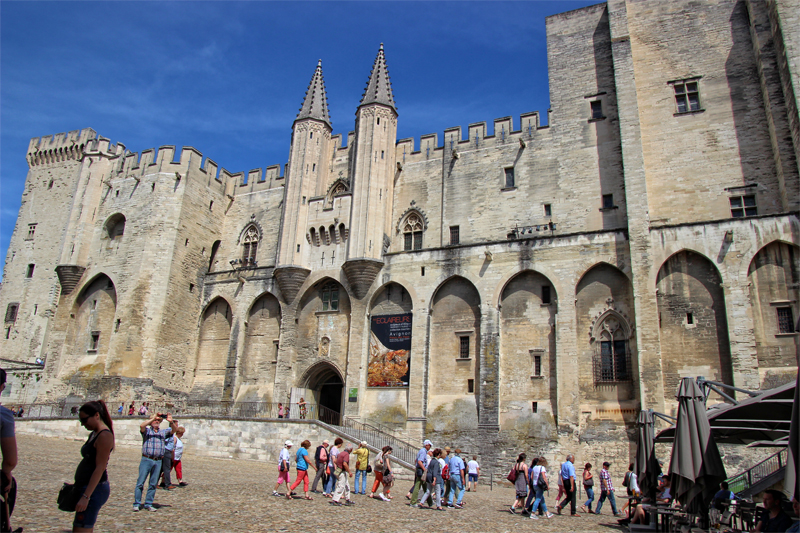
Avignon is the beating heart of Provence, a small city with a big presence.
The main attraction in Avignon is the enormous Palais des Papes (Palace of the Popes). The UNESCO listed former Papal home is incredible, with a majestic presence and light stone walls that reflect the sun and make it shimmer. Built in the 14th century, seven popes in succession ruled Christendom from here. It takes your breath away today to visit both inside, where you’ll see magnificent frescoes, furnishings and lush décor, and outside where a walk around the soaring walls will impress. Hosting art exhibitions and concerts plus a fabulous son et Lumière show from mid-August until the end of September.
Number 2 on the must-see list has to be the famous Bridge of Avignon, the subject of the well-known song “sous la Pont d’Avignon” about dancing on (or rather under) the bridge. To this day people do dance on the ruins of the ancient bridge though for selfies predominantly! The river crossing came about after, in 1177, a 12-year-old shepherd boy claimed divine voices told him the bridge needed building in Avignon.
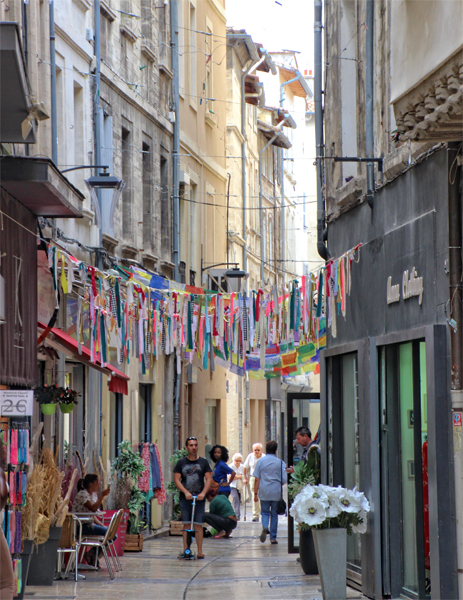
Avignon has one of the most pleasant old cities for strolling and simply ogling the gorgeous buildings, enjoying cobble stoned streets and for taking a break at a terraced café. Leafy squares, bright streets festooned with bunting and a stream with water wheels are just a few things that make this a beautiful city.
Head to the perched park of the Jardin des Doms next to the Palais des Popes for fabulous views over the countryside and to the Ile de Barthelasse, the largest river island in France. If you want to visit the island, there’s a free shuttle bus from near the Pont d’Avignon, take a picnic and enjoy the countryside air.
If you don’t have much time or it’s too hot to trot, simply hop on the little tourist train from outside the Palais des Papes. It’ll carry you round town taking in all the key sites and makes for a fun tour.
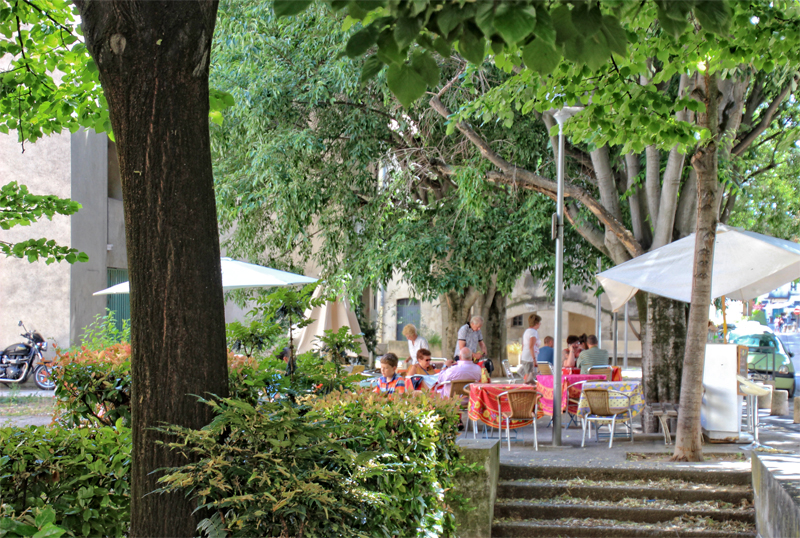
This is a town that loves its food and there’s masses of choice for restaurants, bars and bistros. The Place de l’Horloge is a grand, vibrant square that’s popular with locals and tourists for its numerous restaurants. Or head off to one of the side roads or smaller squares like Places des Corps-Saints for the restaurants the locals love and visitors often don’t discover.
Did you know pastis was invented in Avignon? The word comes from the Provencal “patisson” meaning mixture. What better place to enjoy the oh-so-French liqueur than in its place of birth!
Don’t miss the chance to visit Les Halles, the local covered market. Chocablock with regional products - from luscious olives to herbes de Provence, cheeses, charcurterie and bread, it’s the perfect place to stock up on gourmet goodies.
French Connections have loads of rentals in Provence – just pop over to our listings pages to see what suits you for your dream holiday in the sunny south of France.
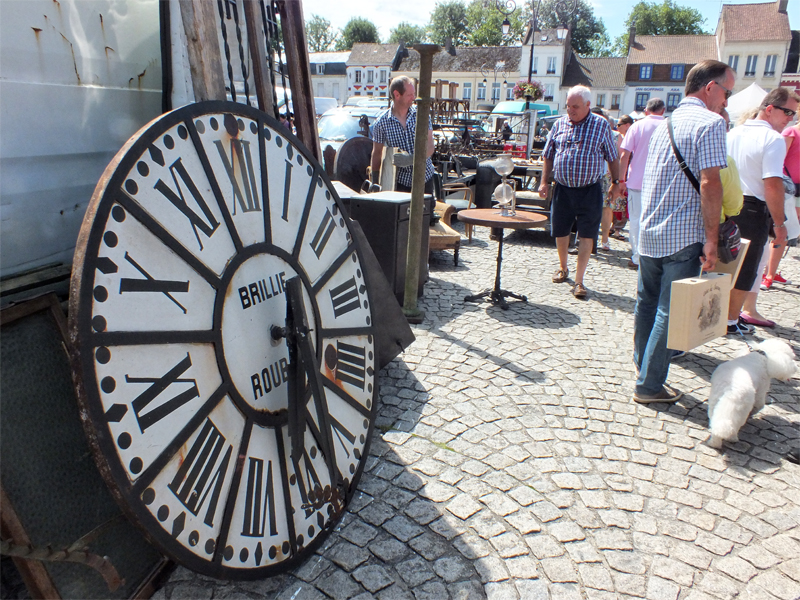
Going to flea markets in France is a national hobby.
If you’re on holiday in France, going to a brocante, vide grenier of marché aux puces as they’re called, is a terrific way to experience the culture of an area and get to know the locals.
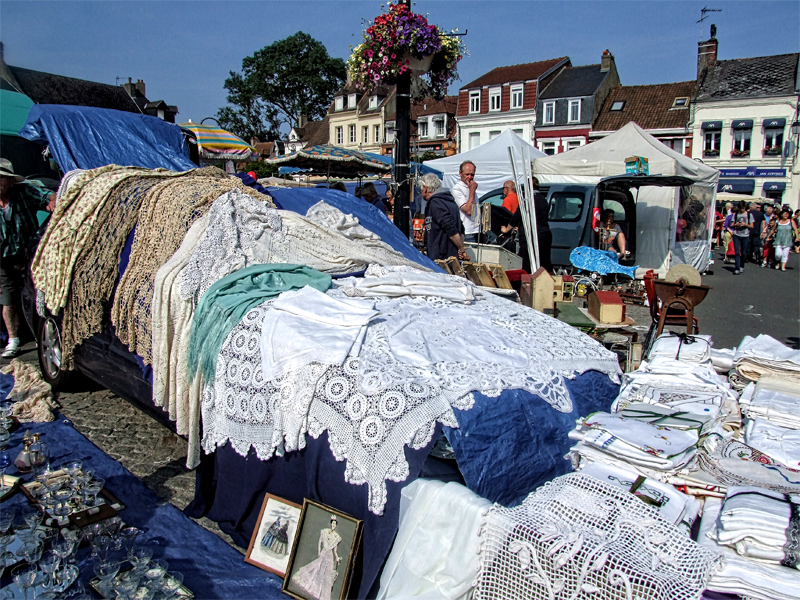
Flea markets generally take place on weekends and national holidays. They might be held just in the morning, all day long, or at night. If we’re talking about the Braderie Lille in northern France - that one goes on for some 36 hours non-stop and is the biggest flea market in Europe with around 10,000 stalls.
Some flea markets are regular affairs like the famous Monday antiques market of Nice, held in the colourful Cours Saleya. Isle-sur-la-Sorgue in Provence is a whole town of antique shops that are open year-round. In Paris there are several regular flea markets such as the Marché aux Puces at Saint-Ouen where there are around 2000 shops and dealers spreading out over 10 miles.
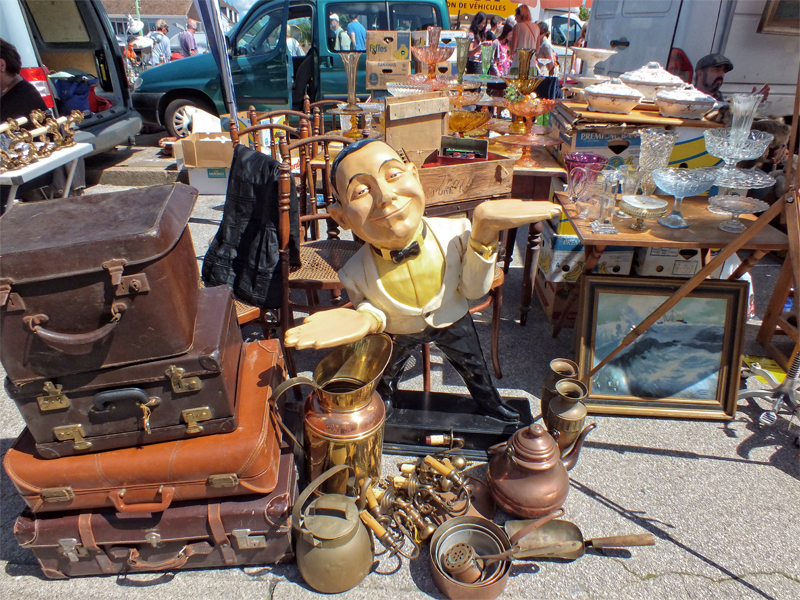
A wander round a local flea market will generally reveal the contents of a local loft or cellar and then some. Professional antique dealers might also be present (and more costly of course). You’re sure to come across plenty of tat but you might just find something that will be the perfect souvenir to take home.
Textiles, table cloths, pieces of lace, antiques, glass, tin coffee jugs, copper utensils, giant clocks, books and magazines – they’re all common sites at a flea market, plus a whole lot more. If kitchenalia is your thing, then a flea market is bound to float your boat. Old furniture, paintings, kids’ toys, hundred-year-old posters, ancient postcards – you never know what you’ll find at flea market.
Usually there will be a barbecue or street food, somewhere to rest and grab a bite or a glass of wine in the shade and watch the browsers. It’s a great way to spend a few hours and get to know a place better.
If you want to know how to find a flea market near where you’re on holiday, ask your host or check on the French website brocabrac.fr… and leave some room in the car to take home your French memento!
At French Connections we like nothing more than helping you make your holidays dreams come true – check out our fabulous gites, b&bs and chateau stays…

Just a short drive or train journey from Paris, the Loire Valley once the playground of Kings, is one of the most popular destinations in France.
For most people, the Loire Valley means one thing – chateaux, and with good reason, some of the most beautiful, legendary castles in the world are found in this part of France. But there’s more to this area and a holiday here means that you’ll enjoy the finest wines, historic villages, fabulous gastronomy, gorgeous gardens and a whole lot more.

No French King or Queen worth their salt would reign without building or tinkering with a chateau in “the garden of France”. But one stands out above all others – Francois I. He is credited with bringing the Renaissance to France and he also brought its cover boy, Leonardo da Vinci to live in the Loire in the little Chateau du Clos Lucé (above), it’s well worth a visit after being magnificently restored, next to his own at Amboise. There are hundreds of chateaux open to the public, seemingly one at every turn, and everyone will have their favourite but the Chateau de Chenonceau (top pic) takes some beating. The stunning flower arrangements and fabulous landscaped gardens, romantic turrets and exquisite architecture make this a very special place to visit.

Vineyard visits and wine tasting opportunities galore are to be had in the Loire. As with chateaux, everyone will have their favourite and you’re utterly spoiled for choice here. One of the most special places for the views and the wine is Sancerre. The town of Sancerre (above) is perched high on a hill overlooking lush vineyards in which grapes grow to make… Sancerre.
The Loire is famous for its mushroom caves and cheeses and just down the road from Sancerre is the little village of Chavignol. Here you can buy direct from the farm, delicious crottin de Chavignol and guess what – it’s perfect with Sancerre!

The Loire is peppered with picturesque villages and historic towns and cities. There are way too many to go into here but just to whet your appetite consider these:
Bourges (above) – winding ancient streets; a chateau fit for a king but built for a commoner albeit a very wealthy one, Jacques Coeur, which got him into trouble; a magnificent Cathedral; fabulous restaurants, gourmet shops and more…
Tours – a great base for touring the chateaux of the Loire Valley. Excellent restaurants, art centres and a great vibe make this one to add to your bucket list.
Saumur – a small town that packs a big castle with the most amazing views over the river Loire.
Blois – boat rides on the river with views you’ll never forget; a truly extraordinary chateau; beautiful cobbled streets – it’s a town to fall in love with.
Angers – home to Cointreau; a fabulous castle with incredible tapestries as well as famous tapestries that are more modern; great foodie destination – a vibrant city that makes for a terrific base.

Known as the garden of France, the Loire has some of the most spectacular gardens in the world.
The internationally renowned gardens of the Domaine de Chaumont-sur-Loire with the annual months’ long festival of garden design is superb – think Kew Gardens meets Chelsea Flower Show.
The gardens of the Chateau du Rivau (above) are like a fairy tale come to life, and the theme in the gardens is, in fact, fairy tale. Giant cups, a tower fit for Rapunzel, a chapel of roses and the most beautiful, imaginative planting and quirky ornamentation make this a stand out visit. They also have a fabulous restaurant.
The Prieure d’Orsan is a little off the beaten track but oh so beautiful. Mysterious, romantic and full of witty, basketed things with a medieval theme – this place is an absolute jewel of a garden.
Explore this beautiful area and stay somewhere fabulous with French Connections – we’re here to help you make your holiday dreams come true…

La Rochelle @ credit La Rochelle Tourism
La Rochelle is the essence of French charm and style. It’s known as la Ville Blanche, the white city, thanks to the many limestone buildings that reflect the sunlight. There’s a pretty harbour surrounded by cafés and stalls plus one of the largest private leisure ports in the world. Historic towers that are hundreds of years old stand watch and usher in the Atlantic. Ancient covered arcades that line narrow streets are home to fabulous cafés, shops and bars.
There’s plenty to do for the whole family in this lovely little corner of Western France.

The aquarium is a bit of a must. Just to the left of the harbour as you look out to sea, it’s one of the largest aquariums in Europe. It’s privately owned, has 83 individual aquariums and takes about two hours to do the whole thing. It explores the Atlantic, the Mediterranean, the Caribbean and the Indo-Pacific oceans and seas.
http://www.aquarium-larochelle.com/en

Take a wander down those historic narrow streets with their timber framed houses and quaint little boutiques. You’ll discover pretty, shaded squares, polished flagstone pavements and beautiful grey-white mansions.

If you’ve got kids, you may well have seen the hit TV show, Fort Boyard. You can take a boat ride to view the 19th-century fort which is oval shaped, 68 metres long with walls 20 metres high and just off the coast of La Rochelle. You can’t actually go into Fort Boyard but it is an impressive sight and the over dramatic commentary of the boat’s speaker system adds to the fun.

The freshest of seafood and a plethora of delectable bars and restaurants make this a foodie’s paradise. One of the most delicious and fun places to eat at is the brasserie Bar André (5 Rue St Jean du Pérot) whose plateaux de fruits de mer have been pleasing guests since 1947. Watching the sun set over the yachts clinking in the harbour will create memories to cherish.
If you fancy a sojourn in the area, check out the fantastic range of French Connections holiday rentals, we’re happy to help you make your dream holiday come true…
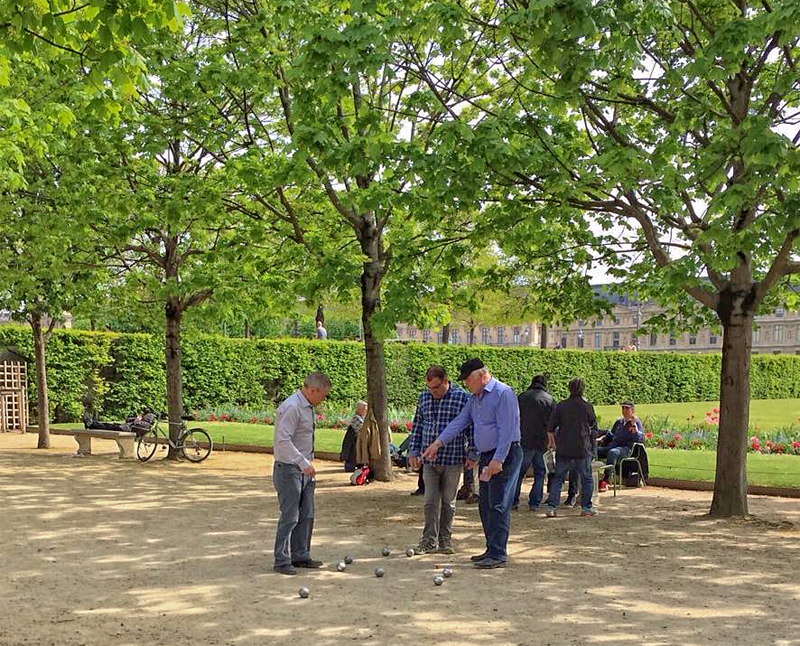
Boules is a game that’s traditionally played with metallic balls on a dirt surface (as long as it’s flat and level!) with a glass of pastis or wine at hand.
Boules or la pétanque as it is sometimes called is played by around 20 million people in France and anyone can easily and quickly learn to play and enjoy this ancient game (it is believed to originate from an ancient Greek game of tossing coins in about 6 B.C.).
The purpose of the game is to win by throwing your balls to land closer to a small coloured ball called a cochonnet which literally means piglet, than those of your opponent.
The game is usually played between two teams of 1, 2 or 3 players. If singles or doubles each player uses 3 boules, in triples 2 boules per player. It’s a great game for families as even little kids can join in this one.
To start, toss a coin to decide who begins the game and has the right to place the cochonnet. If you don’t have a cochonnet, you can use an object of comparable size – a stone or cork from a bottle is usual.
A circle or area is drawn by the winner of the coin toss (or a member of his/her team) in which players must stand and not step outside of while throwing. The circle should be about 0.5m in diameter and at least 1m from any obstacle.
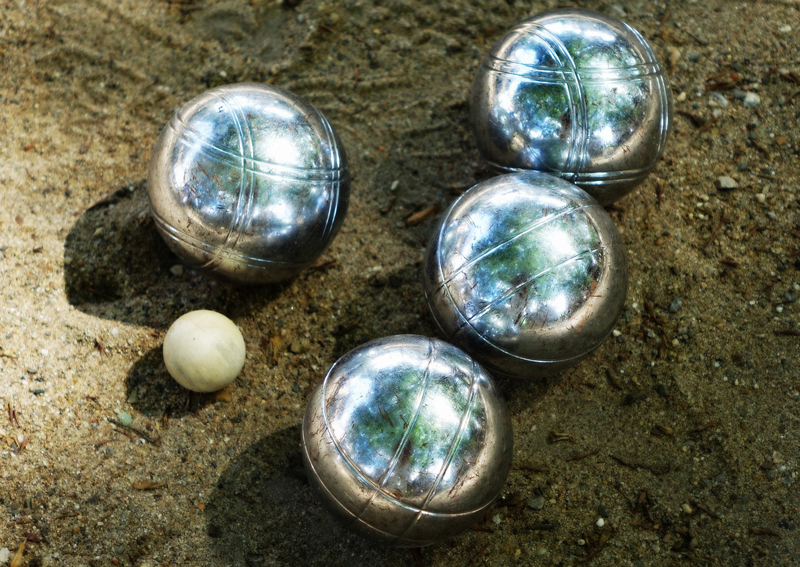
The winner of the coin toss throws the cochonnet between 4m and 8m, or 6 to 10 paces from the circle in any direction – it must not be closer than 1m from any obstacle or you must throw again.
Any player from the coin toss winning team throws the first boule, trying to get it as close as possible to the “cochonnet” without touching it. Both feet must stay together on the ground and within the circle while throwing and until the boule has landed.
A player from the other team then steps into the circle and aims to throw a boule closer to the cochonnet than their opponent, or to knock the opponent’s boule away. If you’re being a stickler for the rules, you should throw within 1 minute of your turn starting.
The winner or winning team starts the new round.
Usually someone produces a tape measure or some means of rule to identify who is nearest to the cochonnet if it’s not glaringly obvious – without it there can be lively debate!
Bon courage…
If you fancy a game of boules in France, check out our ever-growing list of fabulous holiday rentals and B&B properties all over France. We’re here to help you make your dreams come true…

Menton is on the very edge of the Mediterranean, snuggled between Italy and Monaco. It’s an easy day trip from Nice, has beautiful beaches, a fabulous daily market and a gorgeous old town that’s made for wandering.

Legend has it that Menton sprung from a lemon. When Adam and Eve were expelled from Paradise, Eve took with her a golden fruit. Adam told her to chuck it away in case God got even more angry with them. She buried it in the most beautiful place she saw after crossing mountains and plains and from it grew Menton.
These days Menton is famous for its lemons, praised by top chefs the world over and growing pretty much year-round in the mild climate. Lemon and orange trees flourish in parks and gardens, in streets in the town and orchards around.
Every February the town hosts an amazing Lemon Festival with giant fruit sculptures and parades – it’s an absolute must-see.

It was until the late 1800s that Menton became popular with tourists. Royals and aristocracy flocked here, as well as artists, musicians and writers, lured by the light, the sunshine and the beauty of the town.
There’s a strong Italian influence, pale lemon and orange buildings with contrasting pale blue shutters, shady little squares with fountains and winding roads lined with quirky boutiques.
There’s nothing that quite beats sitting at a terraced café, watching the world go by, the church bells ringing, birds tweeting and the scent of blossom and fruit in the air. It’s a chilled place where no one hurries.
Visit the 17th-century Basilica of St. Michael the Archangel via an extraordinary yellow staircase, the Belle Époque covered market with its exquisite smells and vibrant stalls. Experience the Museum of Jean Cocteau - housing the world’s largest collection of works by one of the most multifaceted artists of the 20th century.
Stroll along the Promenade du Soleil where the azure colour of the sea is mesmerising. Laze on the sandy beach, visit the pretty gardens and enjoy 331 days of sunshine!
This storybook town will leave you longing for more.
Dreaming of lemons, sunshine, the Mediterranean waters and magnificent Menton? Browse the hundreds of holiday rentals in the south of France on the French Connections website, we love to help you make your dreams come true…
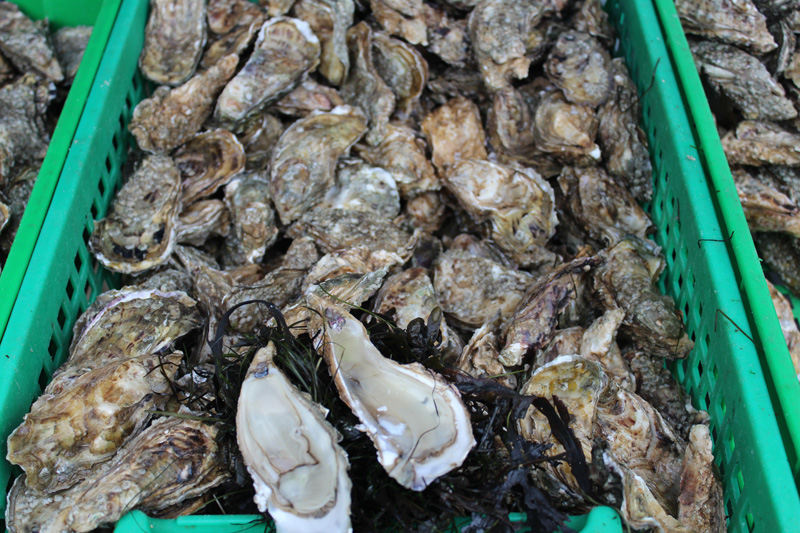
France is the No. 1 consumer and exporter of oysters in Europe producing 150,000 tons every year.
King Henri IV (1553-1610) was said to eat 300 of them at a time, his grandson Louis XIV had them delivered fresh daily to Versailles or wherever he was and was known to eat six dozen at a time. Diderot the French philosopher and Voltaire the writer and philosopher ate them for inspiration, as did Napoleon Bonaparte before going into battle. Casanova, the 18th-century lover used to breakfast on 50 oysters.
To this day the French still can’t get enough of them and they are the food of choice at times of celebration like Christmas and New Year – around half of all oysters eaten in France will be eaten between these two festive dates.
98% of oysters are cupped but they can also be flat (called plats) – and much more expensive. They are ranked for size by number: from 0 to 5 for cupped oysters and from 000 (the biggest) to 6 (the smallest) for flat ones. Cupped oysters are designated “fine” or “special” which indicates the amount of meat, with special oysters being the meatiest ones.
Oysters are almost never rinsed which is to help preserve the flavour. You’ll find them on sale in supermarkets, poissoneries, and at street markets, kept on ice and often beautifully displayed (like these above at the market at La Fleche in the Loir). In restaurants too they are generally served on ice to keep them fresh. Take an especially small fork, gently pry the oyster, squeeze lemon or mignonette sauce, made of chopped shallots and red wine vinegar in the shell, or go au naturel and slurp it back in one gulp.
French for oyster is huître – pronounced wee-tra (without the h).
Oyster bars are known as huiteries and you’ll find them in all major towns.
You generally order demi-douzaine – a half dozen or a douzaine – a dozen
Normandy Oysters: Known for its highly iodised and fleshy oysters. Fans may have their favourites such as the special oysters of Isigny, tasty and pulpy, and those of Saint-Vaast, which are known for their nutty flavour. Utah Beach is said to produce sweet oysters.
Brittany Oysters: Cancale, Saint-Brieuc, Morlaix and the Bay of Brest are all well-known for cupped and flat oysters; most of the small amount farmed are from Brittany.
The Cancale oyster is farmed in the shadow of the Mont Saint-Michel and has a firm and salty flesh.
The Paimpol deep-sea oyster, raised in farms far out in the bay, is deliciously juicy and plump.
Another Brittany celebrity is “the Belon”, whose appellation designates three Brittany estuaries on the south coast of Finistere where the coastal seawater mixes with freshwater from rivers and springs.
The oysters farmed around Quiberon and in the Gulf of Morbihan in southern Brittany grow in richly fed tidal streams and have a distinctive and energising flavour.
Oysters from the Central West Coast: Ile de Ré, Noirmoutier. Oysters farmed off the Vendée coast are highly reputed.
Marennes-Oléron, Charente-Maritime is the most extensive oyster farming area in the world with the advertising slogan “Matured in Marennes-Oléron and nowhere else”. The ancient salt marshes which form the oyster beds give an aroma and sometimes a special hue to the oysters.
Arcachon Oysters:The Arcachon Basin (Aquitaine) has been producing wild oysters since days of old. Today it has become an important breeding centre, supplying spats (oyster larvae) to most of France’s oyster-farming basins. The baby oysters suction onto terracotta tiles placed by the farmers and are then placed in sacks to continue growing.
French Connections has fabulous rentals in all these areas – so why not check them out and va va voom to France and enjoy oysters fresh from the water!